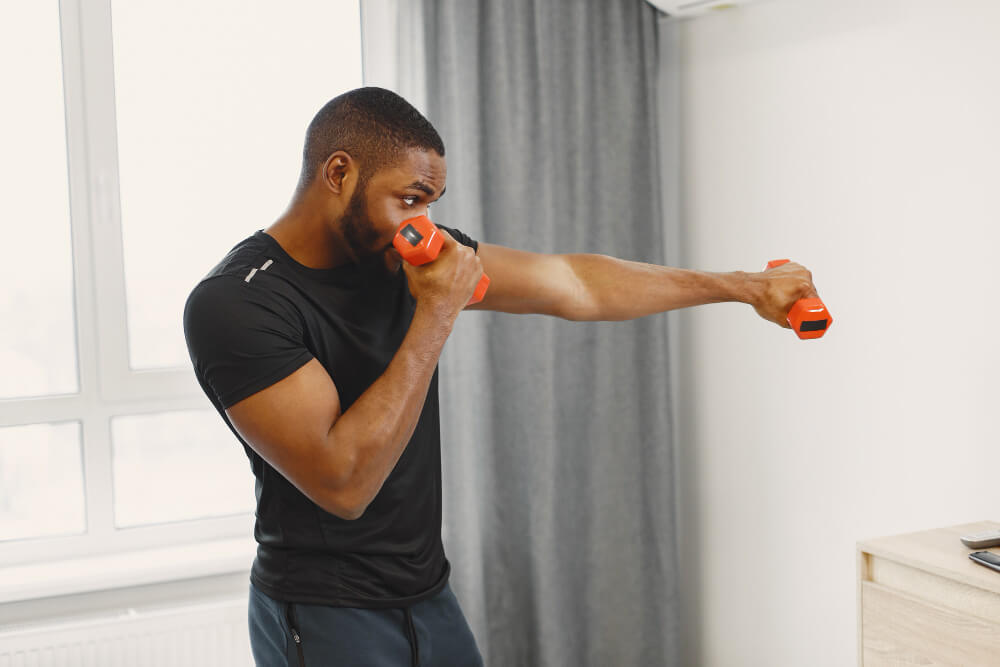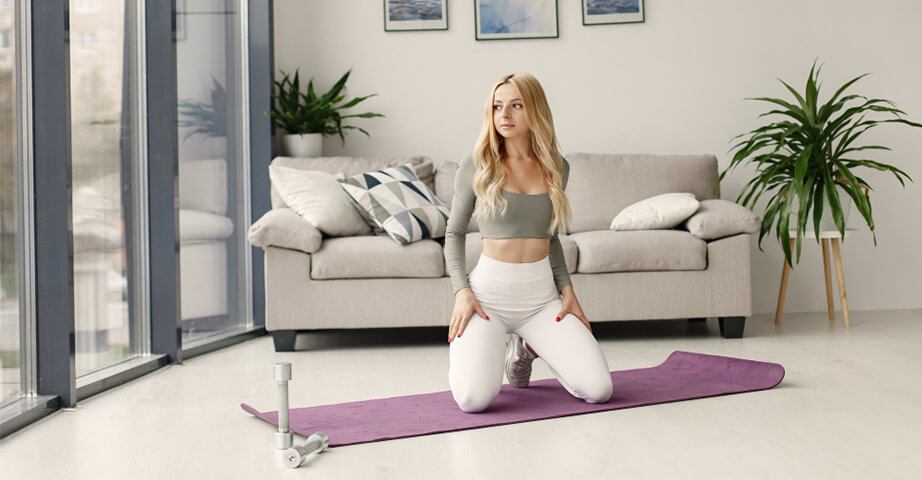Exercise with dumbbells not only for the biceps. How to exercise with dumbbells at home?

The popular view is that exercises with dumbbells are isolation exercises for the biceps and triceps. Indeed, this is their basic, most obvious function. But dumbbells are ideal for numerous multi-joint exercises dedicated to different muscle groups. Dumbbells are an attractive component of resistance and endurance training. They help build muscle and burn more energy during cardio exercises for weight loss. Not sure which exercises you can do with dumbbells? Check it out!
Exercising with dumbbells - why is it worth it?
Do you think exercising with dumbbells is only useful for strengthening and sculpting your biceps or triceps? Nothing could be further from the truth! Dumbbells, which allow you to add and remove loads easily, are a great piece of equipment which can be used for strength workout of various muscle groups, but also for cardio training and to burn fat in the process of weight loss.. Exercises with dumbbells can be just as effective for working on: chest, shoulders, back, thigh muscles, buttocks and abdominal muscles as well as during weight loss.
Exercising with dumbbells allows you to:
- build muscle mass and increase muscle strength,
- increase weights easily during training,
- working on asymmetry and reducing the imbalance between the development of the right and left sides of the body,
- working on muscle-sculpting
- adding variety and improving the effects of cardio training,
- increasing the load on the body during fat loss training, this increasing the number of calories burned.
Dumbbell exercises at home
Dumbbells are incredibly useful during home workouts. It is the basic piece of equipment, next to the mat, that will enable beginners and intermediate people to work on their bodies effectively. If you start exercising at home, a workout based on your own body weight will be sufficient. Over time, however, to continue seeing the effects of training, it is necessary to introduce additional impulses in the form of increased load.. In this case, dumbbells are perfect. With the help of dumbbells, you can perform resistance training on all muscle areas.
Which dumbbells for exercising at home?
Your choice of dumbbells depends on what type of exercise you intend to do, what your training goals are and... how much space you have at home. There are two types of dumbbells to choose from:
- dumbbell of a certain weight, small, handy, covered with a non-slip, usually coloured material to make it easier to grab. The weight of this type of dumbbell starts at 0.5 kg but can be much heavier, even up to 5 kg. Such weights, as they are usually referred to by this name, are mainly dedicated to aerobic activities, cardio, HIIT - general fitness and slimming exercises. Lighter weights are an additional load during fitness exercises. Their purpose is not to develop muscle mass, but rather to increase the level of exertion to which the body is subjected. As a result, more energy is expended during training and the figure is shaped better. As performance increases, heavier and heavier dumbbells may be necessary to ensure that exercise with weights continues to have the desired effect. More storage space is therefore needed.
- barbells, which consist of a short bar, plates and clips. They allow you to adjust the weight very easily to suit your training goals and your body's capabilities. The plates also take up much less space than whole weights. Exercises with such dumbbells are more commonly associated with strength training and, indeed, are well adapted for this purpose. For dynamic fitness activities, they may be too large and not handy enough. However, it does not mean that they cannot be used at all. You can use barbells at home for exercises with lighter and heavier weights. The bar weighs about 1 kg on average and the smallest plate 0.5 kg. If you want to invest once in dumbbells for exercising at home, you can start exercising even with just the bar or by putting on the smallest plates, gaining 2 kg of barbell weight.
Recommended products
Rules for exercising with dumbbells at home
The specific rules for exercising with dumbbells at home depend on whether you choose strength training or cardio. However, these two options can be effectively combined by introducing more dynamic movements into strength training, which will make your heart rate increase. Therefore, the body can work effectively on strength and endurance at the same time.
Exercises with dumbbells are recommended 3-4 times a week. They usually last 30-45 minutes. During this time, several exercises are performed, 3-4 series each and 10-20 repetitions per series. Of course, these are only indicative frameworks and the choice of the number of exercises, series and repetitions depend on the type of exercises chosen as well as the training goals.
Don't forget to warm up before you start exercising with dumbbells and to stretch after your workout. This will help you prevent injury and facilitate recovery.
Dumbbell training - examples of exercises for each muscle area
By training with dumbbells, you can develop the strength and mass of each muscle part. At first, dumbbells are associated with isolated exercises for the biceps and triceps. However, if we look at the possibilities of using dumbbells, it turns out that with their use it is possible to perform mainly multi-joint exercises, involving several muscle groups at the same time. This section describes examples of exercises that can be performed at home during a workout with dumbbells.
Workout with dumbbells - Dumbbell Flyes on the floor
The lying-on-the-floor dumbbell flyes are an exercise that primarily engages the chest and shoulder muscles..
Lie on the floor with your legs bent at the knees. Grab a dumbbell, lift it above you so that the fingers of both hands are pointing towards each other, arms straight, shoulder width apart. Squeeze your shoulder blades together, lowering your shoulders. On the inhale, slowly extend your straight arms so that the dumbbells are just above the floor. On the exhale lift the dumbbells back to the starting position, tightening your chest. As you straighten your arms with the dumbbells, tighten your pectoral muscle, then take an inhale and begin to extend your arms again.
Dumbbell exercises - shoulder raises
Shoulder raises engage the back muscles.
Stand straight with your arms lowered loosely along your torso, holding dumbbells in your hands, palms facing your body naturally. On an inhale, lift the shoulders, with the arms remaining in the same position. At the end of the movement, pull your back muscles together. Hold for a moment and on an exhalation lower the shoulders. Control that the movement is performed by the back muscles, without the help of the shoulders.

Workout with dumbbells - squats
Squats benefit the muscles of the thighs and glutes.
Hold a dumbbell in your hands. Spread your feet slightly wider than hip-width apart. Keep your back straight; your head is an extension of your spine. Do a squat until your knees bend at a right angle. Stay in this position for a while, then stand up, straightening your legs.
Exercises with dumbbells - lying arm and leg raises
Raising your arms with dumbbells to your legs already raised in the air or raised at the same time as your arms allow you to work your abdominal and back muscles.
Lie down on the floor. Lift your legs straight up so that the sides of your torso form a 90-degree angle. Keep your lower torso glued to the floor, and avoid arching it. Raise your arms with dumbbells straight above your head. On an exhale, lift your torso with your hands pointing towards your feet; at the end of the movement, clench your abdominal muscles, relax and return to the starting position on an inhale.
